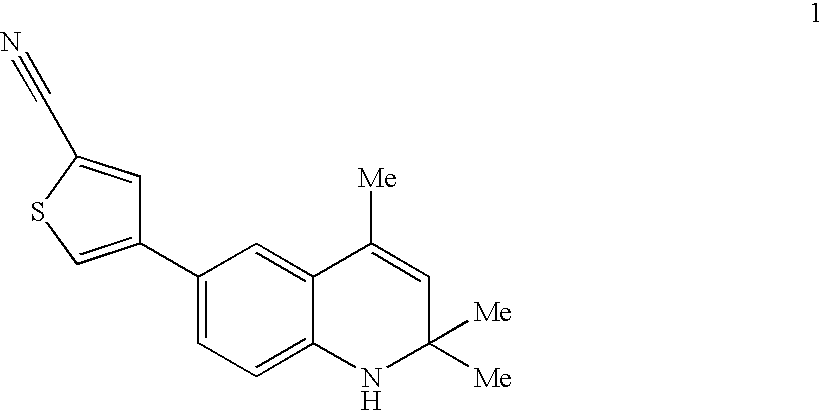Cyclothiocarbamate derivatives as progesterone receptor modulators
a technology of progesterone receptor and cyclothiocarbamate, which is applied in the direction of drug composition, biocide, sexual disorder, etc., can solve the problem of increasing the risk of uterine cancer
- Summary
- Abstract
- Description
- Claims
- Application Information
AI Technical Summary
Problems solved by technology
Method used
Image
Examples
example 1
2-(2-Amino-5-bromophenyl)propan-2-ol
[0193]A solution of 2-amino-5-bromobenzoic acid (10 g, 46 mmol) in dry THF (200 mL) was treated at −78° C. under nitrogen with a solution of methylmagnesium bromide in ether (3.0 M, 90 mL, 270 mmol). The reaction mixture was slowly warmed to ambient temperature, kept stirring for 48 hours under nitrogen and then poured into a cold 0.5 N aqueous hydrochloride solution (300 mL). The mixture was neutralized with aqueous 1 N sodium hydroxide solution and ethyl acetate (300 mL) was added. The organic layer was separated and aqueous layer was extracted with ethyl acetate (3×100 mL). The combined organic layers were washed with brine and dried (MgSO4). After removal of solvent in vacuo, the residue was purified by a silica gel flash chromatography (hexane:ethyl acetate / 3:2) to give 2-(2-amino-5-bromophenyl)propan-2-ol as an off-white solid (6 g, 57%): mp 62–63° C.; 1H-NMR (CDCl3) δ 7.19 (d, 1H, J=2.3 Hz), 7.12 (dd, 1H, J=8.4, 2.3 Hz), 6.51 (d, 1H, J=8.4 ...
example 2
6-Bromo-4,4-dimethyl-1,4-dihydro-benzo[d][1,3]oxazin-2-one
[0194]To a solution of 2-(2-amino-5-bromophenyl)propan-2-ol (18 g, 78 mmol) in dry THF (150 mL) was added 1,1′-carbonyldiimidazole (15.5 g, 94 mmol) under nitrogen. The reaction solution was heated at 50° C. overnight. The solvent was removed in vacuo and the residue was dissolved in ethyl acetate (100 mL). The solution was washed with 1N aqueous hydrochloride solution (2×40 mL), brine (20 mL), and dried with MgSO4. After removal of solvent in vacuo, 6-bromo-4,4-dimethyl-1,4-dihydro-benzo[d][1,3]-oxazin-2-one was obtained as a white solid (20 g, 100%): mp 199–200° C.; 1H-NMR (DMSO-d6) δ 10.32 (s, 1H, D2O exchangeable), 7.48 (d, 1H, J=2.1 Hz), 7.43 (dd, 1H, J=8.5, 2.1 Hz), 6.84 (d, 1H, J=8.4 Hz), 1.61 (s, 6H).
example 3
(1,4-Dihydro-4,4-dimethyl-2-oxo-2H-3,1-benzoxazin-6-yl)boronic acid
[0195]To a solution of 6-bromo-4,4-dimethyl-1,4-dihydro-benzo[d][1,3]oxazin-2-one (2 g, 7.8 mmol) in anhydrous THF (60 mL) was added a solution of n-BuLi in hexane (10 M, 2.4 mL, 24 mmol) at −78° C. under nitrogen. After stirring at −78° C. for 30 minutes, a slurry was obtained and treated with triisopropyl borate (6.5 mL, 28 mmol). The reaction solution was slowly warmed to ambient temperature and quenched with IN aqueous hydrochloric acid solution (60 mL). Ethyl acetate (100 mL) was added, the organic layer was separated, and the aqueous layer was extracted with ethyl acetate (3×60 mL). The combined organic layer was washed with brine and dried with MgSO4. The solvent was removed in vacuo and the residue was purified by a silica gel flash chromatography (ethyl acetate:hexane / 2:1) to afford (1,4-dihydro-4,4-dimethyl-2-oxo-2H-3,1-benzoxazin-6-yl)boronic acid as a white solid (1.4 g, 81%): mp 249–250° C.; 1H-NMR (DMSO...
PUM
| Property | Measurement | Unit |
|---|---|---|
| temperature | aaaaa | aaaaa |
| temperature | aaaaa | aaaaa |
| temperature | aaaaa | aaaaa |
Abstract
Description
Claims
Application Information
 Login to View More
Login to View More - R&D
- Intellectual Property
- Life Sciences
- Materials
- Tech Scout
- Unparalleled Data Quality
- Higher Quality Content
- 60% Fewer Hallucinations
Browse by: Latest US Patents, China's latest patents, Technical Efficacy Thesaurus, Application Domain, Technology Topic, Popular Technical Reports.
© 2025 PatSnap. All rights reserved.Legal|Privacy policy|Modern Slavery Act Transparency Statement|Sitemap|About US| Contact US: help@patsnap.com



